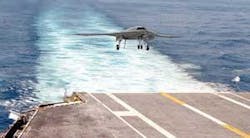By Ben Ames
EL SEGUNDO, Calif.-Landing an airplane on the pitching, rolling deck of a U.S. aircraft carrier is one of the most difficult tasks a military pilot can do. The job gets much harder when there is no pilot on board.
Military engineers at Northrop Grumman Integrated Systems are trying to design a carrier-based unmanned fighter jet to serve in dangerous missions like striking enemy radar centers, or endurance missions like long-term surveillance.
To enable this craft to land on Navy aircraft carriers someday, they chose a landing gear system from Smiths Aerospace in Santa Ana, Calif.
The gear must perform standard tasks like catapult takeoffs and cable-arrested landings, and include features like steering control, anti-skid brakes, and corrosion-resistant materials. The company will deliver the first unit by March 2006.
This $150 million contract makes Smiths the largest nonpartner supplier for the plane, called the X-47B Joint Unmanned Combat Air System (J-UCAS).
In addition to the landing gear, Smiths will supply the holdback-bar mechanism for the carrier catapult system, retraction actuation for the landing gear, vehicle management computers, electrical power generation and distribution systems, mission management computers, remote input/output units, fuel measurement and management through partnership with Argo-Tech of Cleveland, and ground-based data-link computer.
Northrop Grumman is building its X-47B for the Joint Unmanned Combat Air System (J-UCAS) program, controlled through a joint effort by the U.S. Air Force, Navy, and Defense Advanced Research Projects Agency (DARPA).
The group is trying to design a networked system of weaponized, unmanned air vehicles for suppression of enemy air defenses, surveillance, and precision strike. The fleet of vehicles will communicate with each other as well as the Global Information Grid. J-UCAS combines the previous Air Force and Navy programs known as the Unmanned Combat Air Vehicle (UCAV). For more information, see www.darpa.mil/j-ucas/.
Last summer DARPA awarded a $1.04 billion, five-year contract to Northrop, to produce three demonstration planes for flight tests in 2007.
Engineers at Boeing in St. Louis are building a competing platform, called the X-45A. In February, two of those aircraft flew airborne missions at Edwards Air Force Base, Calif., against virtual targets on the ground. In October, DARPA awarded Boeing a $767 million contract for an advanced version called the X-45C. That plane’s first flight is scheduled for Spring 2007.
Northrop Grumman’s X-47B relies on a collection of rugged, redundant networked systems. Its vehicle management computers (VMC) control guidance, navigation, and flight control, using triple-redundant systems to monitor control information and detect faults. It uses an open, distributed system architecture built on IEEE 1394 communication network technology, which has emerged as the standard for next-generation manned and uninhabited vehicles, according to Smiths.
It uses dual mission management computers (MMC) that communicate with the VMCs, to fly the vehicle and operate the sensors in tandem. In fact, the MMC uses a VMC design, extended with solid-state mass memory.
To save the flight weight of signal wires, each X-47B uses nine remote input/output (RIO-1394) products to connect onboard sensors to the VMC. Each RIO-1394 digitizes any analog, discrete, or fuel probe signals, then sends the results to the VMC via IEEE-1394 interface. It also works in reverse, sending VMC commands back to remote locations.
Its electrical power-generation system (EPGS) produces 80 kW at 270-V DC, using a modified version of the generator on the F/A-18E/F fighter jet.
Finally, Northrop Grumman engineers working on the X-47B chose an air data system from Goodrich Corp., Charlotte, N.C. That system reduces the number of discrete sensors on each plane by integrating multi-function sensing ports, pressure sensors, and processing capability. In turn, that increase reliability and decreases weight.




